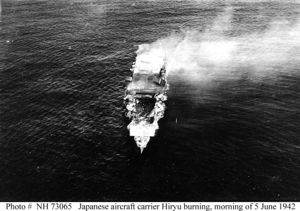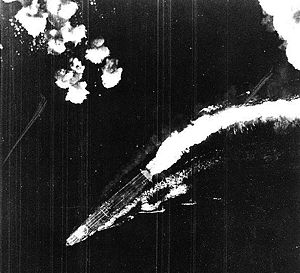Japanese aircraft carrier Hiryū
 Aircraft carrier Hiryū 1939 |
|
| Career (Japan) | |
|---|---|
| Name: | Hiryū |
| Laid down: | 8 July 1936 Yokosuka,Japan |
| Launched: | 16 November 1937 |
| Commissioned: | 5 July 1939 |
| Struck: | 25 September 1942 |
| Fate: | Sunk by air attack in the Battle of Midway on 5 June 1942 |
| General characteristics | |
| Class and type: | Modified Sōryū-class aircraft carrier |
| Displacement: | 17,300 tons (standard), 20,165 tons (full load) |
| Length: | 222.0 m (728 ft 5 in, waterline) 216.9 m (711 ft 7 in, flight deck) |
| Beam: | 22.3 m (73 ft 2 in) |
| Draught: | 7.74 m (25 ft 5 in) |
| Propulsion: | Geared steam turbines, 113 MW (153,000 hp), 4 screws |
| Speed: | 63.9 km/h (34.5 knots) |
| Range: | 7,670 nm at 18 knots |
| Complement: | 1,103 + 23 officers for Carrier Division 2 headquarters |
| Armament: | 12 × 127 mm (5 in) guns 31 × 25 mm anti-aircraft guns |
| Aircraft carried: | 57(+16) 18 Zeros, 18 Vals, 18 Kates (Dec. 1941) |
Hiryū (飛龍, meaning "Flying Dragon") was a modified Sōryū-class aircraft carrier of the Imperial Japanese Navy. She was one of the carriers that began the Pacific War with the attack on Pearl Harbor. After being heavily damaged by air attacks 4 June 1942 at the Battle of Midway, Hiryu sank on 5 June 1942.[1]
Contents |
Design
The ship was built within the specifications of the Washington Naval Treaty that was in place at the time, which placed limits on its tonnage and armament. As a result, the Sōryū and Hiryū were relatively small as fleet aircraft carriers compared to their contemporaries during World War II, carrying around 70 aircraft. Compared to her near sister Sōryū, Hiryū was almost four feet greater of beam, 2,000 tons heavier, and had her island superstructure placed on the port side and farther aft on her flight deck. [1]
The Hiryū was also built with the deficiencies of the Ryujo in mind[2] , which suffered from topweight problems as well as a small flight deck that delayed flight operations. Compared to the Ryujo, the Hiryu had a larger flight deck, hull and an endurance distance extended by nearly 3000 miles.
The port side island was an unusual arrangement; the only other carrier to share this feature was the Japanese aircraft carrier Akagi. The Akagi and the Hiryū were intended to work in a tactical formation with starboard-sided carriers, in order to improve the flight pattern around the formation, but the experiment was not continued beyond those two carriers. [2] The enlarged bridge design created turbulence, causing far greater deck accidents in the Hiryū than her sister carrier.
History
Early Operations
In 1941, commanded by Captain Tomeo Kaku, Hiryū was assigned to Carrier Division 2. On 7 December 1941 she was with the Strike Force in the attack on Pearl Harbor. She launched one wave of planes against the island of Oahu: ten Kates targeted Arizona, California, eight Kates targeted West Virginia, Oklahoma, and Helena and six Zeros attacked US air bases at Wheeler Field and Barbers Point.
From 21 December to 23 December she launched air strikes against Wake Island. In January 1942 she supported the invasion of Ambon in the Moluccas. On 19 February 1942, together with her sister ship Sōryū she launched an air strike against Darwin, Australia.
In March 1942 she took part in the battle of the Java Sea, attacking Allied shipping at Tjilatjep and Christmas Island and sinking the Dutch freighter Poelau Bras. In April 1942 she took part in the Indian Ocean raid, striking Royal Navy bases at Colombo and Trincomalee Ceylon and helping to sink the cruisers Cornwall, Dorsetshire, the aircraft carrier Hermes, and her escort destroyer Vampire.
On 19 April 1942 she pursued the US carriers Hornet and Enterprise after they launched the Doolittle Raid, but failed to catch them.
Midway
In May 1942, Hiryū sailed on her final mission. Her aircraft complement consisted of 21 Mitsubishi A6M "Zero" fighters, 21 Aichi D3A "Val" dive bombers, and 21 Nakajima B5N "Kate" torpedo bombers. [3] On 4 June 1942 she took part in the battle of Midway. At 4:30 AM she launched a strike against Midway Island, destroying planes and damaging installations. After Kaga, Sōryū and Akagi were disabled by air attack at about 10:25 AM, Hiryū was the only operational carrier left to the Japanese. She launched two waves of planes at 10:50 and 12:45 against Yorktown, heavily damaging the American carrier with bombs and torpedoes (she was sunk later by I-168).[1]

Japanese search planes had located the remaining American aircraft carriers, and all surviving aircraft from the Carrier Striking Force had landed on Hiryū and were refueled and armed; but while preparing to launch a third strike against them, Hiryū was attacked at 5:03 PM by 13 SBD Dauntless dive bombers from Enterprise. She was hit by four 1000 lb (453.6 kg) bombs, three on the forward flight deck and one on or near the forward elevator. The explosions started fires among the aircraft on the hangar deck. The forward half of the flight deck collapsed into the hangar bay.
Although Hiryū's propulsion was not affected, the fires could not be brought under control. At 9:23 PM her engines stopped, and at 1:58 AM a major explosion rocked the ship. The order to abandon ship was given shortly afterwards and the survivors were taken off by the destroyers Kazagumo and Makigumo. Rear Admiral Tamon Yamaguchi and Captain Kaku remained on board as Hiryū was scuttled at 5:10 AM by torpedoes from Makigumo. She sank at 9:12 AM, taking 35 men down with her (another 350 or so had been killed by the bombs, fires and explosions). Thirty-five were rescued by the US Navy and taken prisoner. Admiral Yamaguchi's insistence on going down with his carrier robbed the Japanese of one of their most experienced and brilliant carrier admirals.
Ships in class
| Ship # | Ship | Laid down | Launched | Completed | Fate |
| Hiryū (飛龍) | 8 July 1936 | 16 November 1937 | 5 July 1939 | Sunk 6 June 1942 | |
| 800 | Cancelled and re-planned to 15 x Unryū class (Ship # 5001-5015) on 1942 |

Notes
- ↑ 1.0 1.1 Hiryu @ www.history.navy.mil
- ↑ The Encyclopedia of Weapons of World War II. http://books.google.com/books?id=dosAfJErYnsC&pg=PA464&lpg=PA464&source=bl&ots=3HvptbWwg_&sig=2fDQ39kaLstUv5-d8ySrfcY2_38#PPA464,M1. Retrieved 2008-12-13.
External links
|
||||||||
|
||||||||||||||||||||||||||||||||||||||||||||